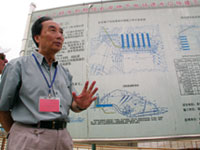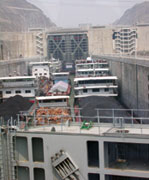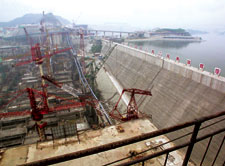Like a gigantic boulder that has been tumbling down a steep slope for a decade, the largest engineering and construction project on the planet is gaining momentum as it heads into its final phase. Chinas massive, multipurpose Three Gorges Dam project is proceeding so smoothly that even long-term opponents concede that the dams progress will not be derailed. The owner apparently has resolved problems from earlier stages, including a fatal tower crane collapse and concrete cracks (ENR 06/07 p. 15). Current criticism focuses on social issues, such as relocation and environmental water quality.
"Weve pretty much accepted that it wont be stopped now. Theyre just too far along," says Patrick McCully, campaigns director with the International Rivers Network in Berkeley, Calif. While acknowledging that the owners technical competence will get the structure built, McCully says "it may be decades" before the world knows whether the dam can control flooding and avoid siltation, the bane of other large global hydro projects.
 |
| OLD HAND Former project engineer Lu, still active as a consultant, charts progress. |
Lu Youmei, former general manager of China Three Gorges Project Development Corp. (CTGPC), says the critics are wrong to focus on individual aspects of the megaproject. Three Gorges is complex, unique and should be viewed in a comprehensive manner, he says. Lu, a civil engineer, is confident that the dams positive aspects outweigh the minuses.
CTGPC fired up the ninth of 14 700-MW generators in the left bank powerhouse in July. Flipping on the switch for the massive turbine instantly pushed more hydropower onto the grid of a power-starved nation. The remaining five units are scheduled for phase-in by the end of 2005. More power from right bank units will follow.
 |
| GATES OF TRADE Locks boost Yangtze traffic. |
Three Gorges power is a keystone of Chinas goal of adding 7.8% more annual generating capacity from 2004-2010, says Li Yong-an, CTGPC president. This will enable the roaring dragon to stay ahead of its 6.8% annual forecast demand increase, he adds. At the same time, the pollution issue has become as omnipresent as the perpetual smog enshrouding the Yangtze Valley. "China is No. 1 in the world in carbon dioxide emissions and No. 2 in sulfur dioxide. We are giving sustainable hydropower development our top priority," Li says.
Also at the dam site last month, the five-level ship locks also officially opened after a years worth of operational testing. Barges queue along the 6.4-kilometer-long left bank channel dual-lane chamber, waiting to be lifted or lowered 113 meters to circumvent the dam. Designers promised a speedy 2.5-hour pass-through, but in May and June it often took four to six hours for a diverse, crowded fleet of 10,000-ton vessels to make the transit.
With the ship lock, spillway and left bank powerhouse in operation, the busiest place on the jobsite these days is on the right bank. The Chinese finished the cofferdam on that side of the river last year, shut the diversion channel and sent the Yangtze back into its mainstream. The reservoir pool rose as planned to 139 m at the dam face this spring. At that level, each generator cranks out 580 MW of power, says CGTPC engineer Hu Daisong. When operators dropped the level to 135 m before the summer rains came, the yield slipped to 550 MW.
 |
| LAST THIRD With cofferdam creating a dry work pit on the Yangtzes right bank, tower cranes place concrete for the final segment. |
Jobsite Beehive
The loss in electricity production is offset by a measure of flood control during the wet season and added safety for a small army of workers. For the past decade, construction has proceeded from the left bank to the center spillway. On that side, work remains on a single-stage, 3,000-ton passenger ship lift and the commissioning of the five remaining generator/turbine sets. But the epicenter now is a dry pit on the right bank. Downstream from the coffer dam, there are some 11,400 workers on three shifts daily. They are running a vast batch plant and conveying roller-compacted concrete to the remaining dam section. Nearby, crews are excavating rock for the powerhouse and intake tunnel and building footings for generating machinery.
|
The three major contractors are all headquartered 40 miles downriver in Yichang, but many members of the work force live in dormitories at Sandouping, the site of the dam. The largest outfit, Gezhouba Construction, boasts a work force of 6,200. Many of them worked on the Gezhouba Dam, which was completed in the 1980s. Regarded as the Three Gorges A team, they primarily are responsible for running an onsite batch plant and placing concrete in the powerhouse foundation and along the remaining 584.2-m-long dam segment.
Qing Yun Hydrology Consortium backstops Gezhouba on the dam face with 3,500 workers. Another 1,700 with a quasi-public company called the 378 Power & Hydraulics Consortium supports powerhouse work. The government formed...

Post a comment to this article
Report Abusive Comment